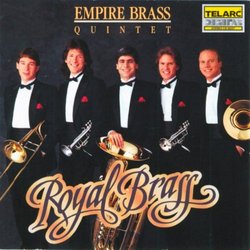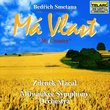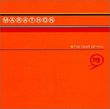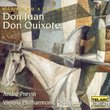| All Artists: Jean-Joseph Mouret, Antony Holborne, Giovanni Pierluigi da Palestrina, Giovanni Priuli, Johann Hermann Schein, Samuel Scheidt, Anonymous, Johann Sebastian Bach, Tomaso Albinoni, George Frederick Handel, Johann Jacob Froberger, Johann Chistoph Pezel, Domenico Scarlatti, Empire Brass Title: Royal Brass: Music from Renaissance & Baroque Members Wishing: 2 Total Copies: 0 Label: Telarc Release Date: 10/10/1990 Genres: Dance & Electronic, Special Interest, Classical Styles: Opera & Classical Vocal, Chamber Music, Forms & Genres, Rondos, Sonatas, Historical Periods, Baroque (c.1600-1750) Number of Discs: 1 SwapaCD Credits: 1 UPC: 089408025723 |
Search - Jean-Joseph Mouret, Antony Holborne, Giovanni Pierluigi da Palestrina :: Royal Brass: Music from Renaissance & Baroque
 | Jean-Joseph Mouret, Antony Holborne, Giovanni Pierluigi da Palestrina Royal Brass: Music from Renaissance & Baroque Genres: Dance & Electronic, Special Interest, Classical
|
Larger Image |
CD DetailsSimilar CDs
|
CD ReviewsTruly Regal Brass Music Played to Imperial Standards! James Yelvington | USA | 07/18/2008 (5 out of 5 stars) "
I'm surprised no one else has offered a review of this CD of brass music, but as that's the case, I offer my assessment. First of all, the performing group, the Empire Brass, is one of the most distinguished in the U.S., and the entire world. I have a good number of their recordings, and there is hardly one among them I'd rate less than excellent. The five players--2 trumpets, horn, trombone, and tuba--are, on the evidence of their recordings, first-rank artists who regularly combine forces synergistically to produce some of the finest brass music around: music which bears their unique imprint, a certain unmistakable style and sound which sets their performances apart. On this disk they augment their forces on 7 of the 20 tracks to include the very apt and stimulating touches of percussionist Richard Jensen. The title of the disk no doubt comes from the fact that virtually all of the composers present have in some way served "royal" personages: kings, queens, princes, emperors, popes. The subtitle of the disk tells us what style of music is in store: "Music from the Renaissance & Baroque." (The great majority of the works are Baroque, but the few Renaissance pieces add much to the charm of the program.) For readers who merely want a quick evaluation of the CD's merits, I offer the following critique. The Brass play here with pretty much all their usual finesse: only perhaps in a spot or two may there be the slightest departure from their accustomed grace, hardly worth mentioning. There are, however, a few tracks on which I feel the balance could be better: the bass (tuba) could receive somewhat more emphasis. (That would not be due to any deficiency in the playing, but to the engineering of the recording.) To compensate, there are several other tracks which are simply exquisite. On balance, the disk is a first class presentation of some really fine brass music, and I have no hesitation in giving it the highest rating. Comments on some of the individual works follow. Jean-Joseph Mouret's "Rondeau" which we all know as the theme of PBS' Masterpiece Theater is played in a lively, almost sprightly way, with snare drum. It is refreshing to hear this late Baroque piece played with a little less majesty and a little more spirit than we're accustomed to. A great job! Holborne, an Englishman of the Renaissance hardly known today, was clearly well known in his own time, as John Dowland dedicated one of his songs to "the most famous Anthony Holborne." This varied and witty set of 5 short pieces shows why he was so popular then, but leaves us wondering why he's not better known today: his music is first-rate and absolutely delightful. The Brass deserve special credit for bringing this music to our ears in such a charming way! Palestrina is the towering figure of Italian Renaissance vocal church music. Attribution of this instrumental "Ricercar del primo tuono" to him is regarded by current scholars as very dubious. Still, it's a fine, smoothly written piece, a credit to its composer--whoever that may be. Giovanni Priuli, an organist and composer transitional between the Italian Renaissance and Baroque, wrote sacred vocal music in the older style and secular madrigals and instrumental music in the newer style. Though he's not much known today, he was quite successful in his time, being a respected associate (and possibly a student) of Giovanni Gabrieli in Venice. He later spread the Italian style to Austria, where he held positions at the Habsburg courts of Archduke Ferdinand, later Holy Roman Emperor Ferdinand II. This 6-part canzone features short motifs in lively imitation interspersed with sonorous, full chordal passages. A recording no less than marvelous! Johann Hermann Schein, an early Baroque composer, helped introduce Italian musical styles into the more northerly German lands in spite of never having visited Italy. His only work of instrumental music was his Banchetto Musicale (probably meant to be played by viols for social occasions), from which the "Paduana & Galliard" are taken. The slow, stately, and harmonious Paduana (Pavane), is a processional dance form named for the city of Padua. It is followed by the faster, more vigorous, Galliard using related thematic material. The use of drum and tambourine accentuates the dance-like character of the pieces. A fine performance! Holborne returns with an "Elizabethan Dance Suite," a form which he had thoroughly mastered, again displaying his compositional magic and inspiring the Brass to deliver an equally delightful recorded performance. Samuel Scheidt's "Canzona bergamasca" is an instrumental piece nominally in the style of the city of Bergamo, Italy. It begins with a light and very lively duple-meter section (in 2/2) full of imitation, wit, and virtuosic display--with what sounds like double-tonguing in all voices including the tuba--eventually giving way to a less active section based upon the same motifs and in the same tempo but with the beat now divided into 3 parts (6/4 time). Then it's back to the original rhythm for a restatement of the first theme and a decisive close. Nothing stodgy about this music, which is a real treat for the ears. Two anonymous 15th century fanfares follow, emphasizing the treble instruments and omitting some of the lower ones, such as the tuba (but including a snare drum). The first has a familiar ring, so I assume it's been used recently in some public forum, perhaps a sports event. I did not recognize the second one offhand. Both are fine, brilliant fanfares and sound quite up-to-date despite their antiquity. A sprightly march from J.S. Bach's cantata 207a highlights the Empire Brass's special affinity for the work of the great Baroque master. No one listening to this or any of their other Bach performances can doubt that the group is made up of Bach-lovers! This, however, is a track which I believe could profit from more emphasis on the bass. Though all parts are played beautifully, the trombone and tuba and do not get their share of the sound, and the overall balance seems somewhat top-heavy. It is good to hear some genuine Albinoni for a change! The suite reminds us of the compositional talent of this Baroque master, who was also an outstanding violinist. Born thirteen years before Bach, he managed to outlive that giant by a year, passing away in 1751 after nearly eighty years of music-making. A man of independent means, he was able to do much as he pleased, and we are fortunate that it pleased him to create the large quantity of music passed down to us. The suite, in 3 movements (fast-slow-fast), is well crafted and fully enjoyable. Again, the sonic balance seems less than ideal to my ears, with the lower voices a trifle underweight, especially in the contrapuntal sections where all voices should be equal. The Bach trio sonata in G major was originally written for organ in three voices, one for each of two manuals and one for the pedals. The three movements are in fast-slow-fast arrangement and all three are substantially contrapuntal in character. The music is some of Bach's very best, imaginative, beautifully worked out, and sensuously appealing. The balance of forces again seems to slight the lower voices, particularIy the tuba, which has a very lively, beautiful, and significant part played here with consummate skill and artistry. Händel's aria is a clever, spirited, and tuneful work originally written for a military ensemble with 2 oboes, 2 horns, and bassoon. The snare drum's presence seems in keeping with the character of the music, which does not sound like a typical aria. A little-known work, it provides a treat by shedding light on an unfamiliar facet of the Baroque master's oeuvre. Johann Jakob Froberger was a German Baroque composer and keyboard virtuoso who died some 13 years before J.S. Bach was born and wielded substantial influence upon many of his European contemporaries through his travels, friendships, and circulated copies of his (unpublished) music. He studied with Frescobaldi in Italy and had a strong impact upon the keyboard music of Louis Couperin. He helped to develop and standardize the Baroque keyboard suite to include among its movements the allemande, courante, saraband, and gigue. Besides suites he wrote numerous toccatas, fantasias, and other instrumental works for harpsichord/clavichord or organ. The keyboard toccata here is quite typical of his polished style and transports quite effectively to brass quintet. The fugue from J.S. Bach's trio sonata in C Major displays his wizardry over this rather abstract contrapuntal form. Intellectually appealing as it is, it is also a pleasure to hear and, I suspect, to play. Johann Christoph Pezel lived during the last two-thirds of the 17th century in what is now Saxony in northeastern Germany. One of the town musicians at Leipzig, he was obliged to play twice a day from the town tower, in addition to other musical duties. He wrote intradas and dance movements, especially for brass quintet, so the Sarabande presented here is typical of his considerable output. Domenico Scarlatti is known for his huge output for the harpsichord, of which instrument he was a master of the highest rank, as well as teacher to the Spanish royal family. (Though born in Italy in the same year as Bach and Händel, he spent most all of his working life in Spain.) Among over 500 sonatas and exercises, this sonata is typical of his creative imagination and exuberant wit. This is a fine CD featuring excellent brass quintet playing of varied and delightful music, both familiar and new. The sound quality is also excellent, though, as noted, the balance among instruments here or there may be less than perfect. " |

 Track Listings (20) - Disc #1
Track Listings (20) - Disc #1



